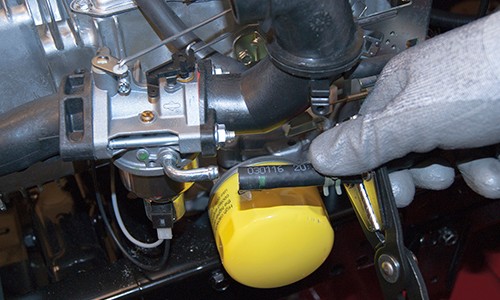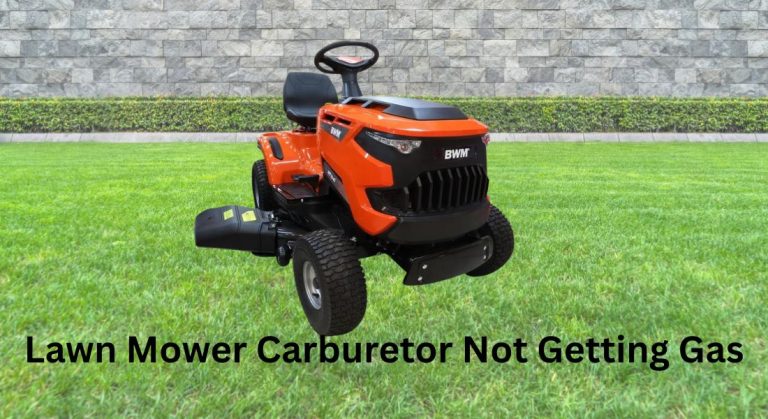Your lawn mower sputters, won’t start, or dies shortly after firing up—frustrating, right? When a lawn mower carburetor is not getting gas, a few quick checks often solve it fast: verify fresh fuel, open the fuel shutoff valve, and confirm the fuel filter and fuel line aren’t clogged. Many times, replacing a clogged fuel filter or clearing a blocked fuel line is all it takes to get you mowing again.
In this complete guide, you’ll learn the most common reasons your lawn mower carburetor isn’t getting fuel, how to diagnose them step-by-step, and the best repair methods—from simple fixes like venting the gas cap to advanced solutions like cleaning or rebuilding the carburetor. By the end, you’ll know exactly how to get fuel flowing, prevent future issues, and decide when professional service is worth it.
Common Causes of a Lawn Mower Carburetor Not Getting Gas
- Empty tank or old, stale fuel (varnish and deposits restrict flow)
- Closed or faulty fuel shutoff valve
- Clogged fuel filter
- Collapsed, cracked, or clogged fuel line
- Blocked fuel tank outlet or debris at the pickup screen
- Non-venting gas cap creating vacuum lock
- Failed fuel pump (on some riding mowers or engines with pump)
- Stuck float/needle valve inside carburetor
- Clogged main jet or emulsion tube inside carburetor
- Gummed-up carburetor from ethanol fuel deposits
- Air leaks at intake manifold or carb gaskets (less common but impactful)
How to Fix a Lawn Mower Carburetor Not Getting Gas

Important: Always work in a well-ventilated area away from sparks/flames. Disconnect the spark plug wire before working on the fuel system.
Method 1: Quick Checks and Fast Fixes
Diagnosing the Issue
- Symptom: Engine won’t start or dies after starting with starter fluid.
- Likely causes: No fuel reaching carb, vacuum-locked tank, clogged filter/line.
Fix Steps
- Verify fuel level and quality
– If fuel is older than 30–60 days, drain and refill with fresh, ethanol-free gas if possible (or use fuel with stabilizer). - Ensure fuel valve is open
– Inline lever should be parallel with the fuel line to be open. - Check the gas cap vent
– Loosen the cap and try starting. If it runs with a loosened cap, the cap vent is clogged. Replace the cap. - Inspect the fuel line
– Look for kinks, cracks, or collapse. Replace any questionable line with 1/4″ fuel-rated hose for small engines. - Replace the fuel filter
– Install with the arrow pointing toward the carburetor. If in doubt, replace—filters are cheap and commonly clogged. - Prime bulb check (if equipped)
– Press the primer and observe fuel moving through the clear line or into the carb bowl. No movement suggests upstream blockage or bulb failure.
Testing
- After these fixes, try starting. If it still won’t run unless you spray carb cleaner/starter fluid into the intake, proceed to Method 2 or 3.
Method 2: Verify Fuel Flow to the Carburetor
Diagnosing the Issue
You need to confirm whether fuel reaches the carb’s inlet. This distinguishes a supply problem (tank to carb) from a carb-internal problem.
Fix Steps
- Clamp the fuel line
– Use a fuel line clamp or pinch-off tool between the tank and filter to prevent spillage. - Remove the fuel line at the carb inlet
- Place the line in a container
- Unclamp briefly and observe flow
– Strong, steady flow: supply is good; likely carb issue.
– Weak or no flow: blockage upstream (tank outlet, filter, line, valve). - If flow is weak, isolate components
– Remove/replace filter; re-test flow.
– Disconnect line at tank outlet; check if tank outlet flows freely.
– Inspect tank for debris; clean tank and pickup screen if present.
– Replace brittle or ethanol-damaged lines.
Testing
- Reconnect everything and start the engine. If supply is confirmed but engine still starves, move to Method 3.
Method 3: Clean the Carburetor Bowl, Float, and Needle Valve
If fuel reaches the carb but doesn’t enter the bowl, the float needle may be stuck closed or varnish may be blocking the inlet.
Diagnosing the Issue
- Primer bulb stays flat or offers no resistance.
- No fuel in carb bowl or fuel drips when you tap the bowl lightly (stuck float).
Fix Steps
- Remove the carb bowl
– Clamp fuel line; remove the bowl nut (often a 1/2″ or 10 mm, sometimes it’s also the main jet). - Inspect the bowl
– Look for varnish, rust, water beads. Clean thoroughly with carb cleaner and a clean rag. - Check the float movement
– Gently move the float up/down. It should move freely and shut off fuel when raised. - Clean the needle and seat
– Remove the float pin; take out the float and needle. Spray carb cleaner; blow with compressed air (light pressure). Do not damage rubber tip or seat. - Clean the bowl nut jet (if applicable)
– Many Briggs & Stratton and Tecumseh carbs use a bowl-nut main jet with tiny lateral holes. Poke holes with a fine wire from a wire brush or tip cleaner; flush with carb cleaner. - Reassemble
– Ensure the bowl gasket is intact. Reinstall the bowl; align correctly; tighten snugly—do not overtighten.
Testing
- Restore fuel flow, prime if applicable, and start. If it runs better but still surges or dies under load, go to Method 4.
Method 4: Full Carburetor Cleaning or Rebuild
For persistent issues, a full teardown and cleaning restores proper metering.
Diagnosing the Issue
- Engine only runs on choke
- Surging at idle or mid-throttle
- Fuel seen at line, but starvation persists
- Unit sat with ethanol fuel for months
Fix Steps
- Remove the carburetor
– Photograph linkages and springs. Disconnect throttle/choke links and governor spring carefully. Remove mounting bolts. - Disassemble
– Remove float, needle, jets, emulsion tube, idle mixture screw (count and note turns to lightly seated). - Soak and clean
– Soak metal parts in carb cleaner dip or ultrasonic cleaner for 20–30 minutes. Do not soak rubber or plastic parts.
– Use carb spray and compressed air to clear all passages, especially idle and main circuits. - Inspect and replace wear items
– Install a carburetor rebuild kit: gaskets, needle, seat (if replaceable), o-rings, bowl gasket. Kits cost $10–$30 for common models. - Reassemble and set baseline
– Set mixture screws to factory baseline (commonly 1–1.5 turns out from lightly seated if adjustable). - Reinstall and connect linkages
– Ensure no vacuum leaks. Replace intake gaskets if brittle.
Testing
- Start and allow to warm 2–3 minutes. Fine-tune idle and mixture if adjustable. Verify smooth acceleration without choke.
Method 5: Check Fuel Pump and Vacuum Pulse Line (Riding Mowers/Some Engines)
Some engines use a vacuum-operated fuel pump to move fuel from the tank to the carb.
Diagnosing the Issue
- Good fuel in tank, clear filter/lines, but weak or no fuel flow at carb inlet.
- Translucent filter never fills.
- Cracked or loose vacuum pulse line from engine to pump.
Fix Steps
- Inspect the pulse line
– Replace if cracked, soft, or oil-soaked. Ensure tight connections. - Test pump output
– Disconnect outlet line to carb, crank engine—fuel should pulse out strongly into a container. - Replace pump if weak
– Pumps are inexpensive ($15–$40). Match inlet/outlet orientation.
Testing
- Confirm steady fuel delivery and normal running without choke.
Prevention Tips and Maintenance Advice
- Use fresh, quality fuel; avoid storing fuel >60 days. Add fuel stabilizer if seasonal storage is expected.
- Prefer ethanol-free gas (E0) when possible; ethanol attracts moisture and forms varnish.
- Install a high-quality inline fuel filter and replace annually or every 50 hours.
- Drain carburetor bowl or run the engine dry before long storage.
- Replace fuel lines every 2–3 years or at first signs of softening/cracking.
- Keep the tank cap vent clean; replace caps that don’t vent properly.
- Service air filter regularly; an overly rich mixture from a clogged air filter can mask fuel issues.
Detailed Symptoms and What They Mean
Runs only on choke
A classic sign the main jet/emulsion tube is restricted. Cleaning or rebuilding the carburetor is needed.
Starts then dies after a few seconds
Fuel bowl empties due to blocked vent (gas cap), clogged filter, stuck needle valve, or failing fuel pump.
Primer bulb doesn’t fill or stays collapsed
Air leak or blockage between tank and carb; non-venting cap; cracked primer bulb line; stuck float needle.
Surging/hunting at idle
Clogged idle circuit or air leak at carb/intake gasket; clean passages and replace gaskets.
Pro Tips
- Label and photograph throttle/choke linkages before removal to avoid reassembly guesswork.
- Use a wire from a brass brush to clear jets; avoid steel needles that can enlarge orifices.
- When testing fuel flow, elevate the tank (if detached) to maintain gravity feed for accurate results.
- Replace the bowl gasket every time you remove it if it’s swollen or flattened to prevent air leaks.
- If the engine sat for a year or more with ethanol gas, skip straight to a full carb rebuild or replacement.
- Keep a small engine tune-up kit on hand: spark plug, air filter, fuel filter, fuel line, and carb cleaner.
- Consider upgrading to a shutoff valve if your mower doesn’t have one; it eases maintenance and storage.
Professional Help: When to Call a Pro
- You’ve confirmed good fuel supply to the carb, cleaned/rebuilt it, and the engine still starves or only runs on choke.
- Severe corrosion inside the carb body or stripped mixture screws/jets.
- Persistent vacuum leaks you can’t seal, or damaged intake manifold.
- Riding mower with complex fuel pump/tank routing or inaccessible carb.
- Warranty coverage still active—avoid DIY carb disassembly if it could void coverage.
What to look for in a service provider:
– Small-engine certification or manufacturer authorization (Briggs & Stratton, Kohler, Kawasaki).
– Transparent diagnostic fee and estimate.
– Warranty on parts and labor (typically 30–90 days).
Typical costs:
– Carb cleaning/rebuild: $75–$150 parts and labor.
– Carb replacement: $60–$200 (part) plus labor.
– Fuel pump replacement (riding mower): $80–$180.
Warranty considerations:
– Using non-approved parts or altering carb settings can void manufacturer warranties. Keep receipts and follow OEM specs.
FAQ
Q: How do I know if the carburetor is clogged or if it’s a fuel supply issue?
A: Disconnect the fuel line at the carb inlet and check flow. Strong flow means the supply is fine and the carb is likely clogged. Weak or no flow points to a tank, filter, line, or pump problem.
Q: Can I use carb cleaner without removing the carb?
A: You can remove the bowl and spray cleaner into jets and passages for a partial clean. This often fixes minor varnish issues. For severe clogs, remove and fully clean or rebuild the carb.
Q: Why does my mower only run on choke?
A: The choke enriches the mixture. If it only runs on choke, the main jet or emulsion tube is restricted, or there’s an air leak. Clean the carb thoroughly and inspect/replace intake gaskets.
Q: Does ethanol fuel cause these problems?
A: Yes. Ethanol attracts moisture, leading to corrosion and varnish that clogs jets and sticks float needles. Use fresh fuel, consider ethanol-free gas, and add stabilizer for storage.
Q: How often should I replace the fuel filter?
A: Replace annually or every 50 hours of operation, or any time you notice reduced flow or contamination in the filter.
Q: My primer bulb doesn’t fill. Is it bad?
A: Not always. It could be a blocked fuel line, non-venting gas cap, or stuck needle. If lines and cap are fine, the primer bulb or its check valves may be faulty and need replacement.
Q: Should I rebuild or replace the carb?
A: If the carb body is sound, a rebuild kit ($10–$30) usually restores function. If it’s heavily corroded or damaged, replacement is faster and sometimes cheaper overall.
Alternative Solutions
Sometimes, replacing components is more efficient than deep cleaning, especially on budget walk-behind mowers.
| Solution | Pros | Cons | Best For |
|---|---|---|---|
| Inline filter and hose replacement | Fast, cheap, removes common restrictions | Won’t fix internal carb clogs | Routine maintenance or minor flow issues |
| Carburetor rebuild kit | Cost-effective, restores performance | Requires time/skill | Moderate varnish, adjustable carbs |
| New aftermarket carburetor | Quick install, often <$40 | Variable quality, tuning may differ | Severe corrosion or time-sensitive repairs |
| Ethanol-free fuel + stabilizer | Prevents future clogs | Slightly higher fuel cost | Seasonal equipment and infrequent use |
Get Your Lawn Mower Working Again
Following this guide, you now have multiple solutions to fix a lawn mower carburetor not getting gas:
– Quick checks: fresh fuel, open shutoff valve, venting gas cap
– Fuel flow diagnostics from tank to carb
– Carb bowl/float cleaning and jet clearing
– Full carburetor rebuild or replacement
– Fuel pump inspection for riding mowers
Don’t let fuel starvation stall your weekend. Work through these steps in order, and you’ll restore smooth fuel delivery and reliable starts. Have you fixed your mower’s fuel issue? Share what worked for you below—your experience can help other readers get back to cutting clean lines. Found this helpful? Bookmark it for your next tune-up.




